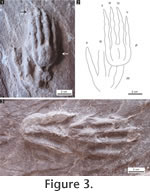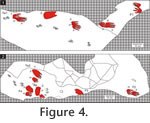|
|
|
SYSTEMATIC ICHNOLOGYTacheria igen. nov. Etymology. Refers to "the hands" (greek τα χέρια, the hands), how the traces are known by the local inhabitants of Vinchina. Geographic and stratigraphic location. Preserved at the Vinchina Formation at La Troya creek, nearby San Jose de Vinchina town, La Rioja province, Argentina. Type ichnospecies. Tacheria troyana Diagnosis. As is a monospecific ichnogenus, the diagnosis is the same as for the ichnospecies. Tacheria troyana isp. nov. 2007 "huellas cuadrúpedas tetradáctilas" Melchor et al., p. 54. 2009a "large tetradactyl rodent-like footprints" Krapovickas et al. 2009b "large tetradactyl rodent-like footprints" Krapovickas et al. 2010 "large tetradactyl footprints" Melchor et al., p. 7.
Holotype. The set manus-pes Tw1-1 included in one trackway (Tw1) with four footprints sets (Figure 3 and Figure 4). Material preserved in situ. Paratypes. Trackway 2 (Tw2) and four isolated sets of manus-pes footprints (F1-F4). Referred material. One set of manus-pes footprints (Figure 5). Comment. The referred material comes from Cenozoic deposits of the Quebrada del Jarillal Formation at Sierra de Mogna (Middle-Late Miocene), San Juan province, Argentina. The footprints were originally described and illustrated by Casamiquela R.M. in Cuerda et al. (1984, plate XV, figure 2 and plate XVI, figures 1, 2) and later also documented by Leonardi (1994, plate XIX, figure 11). Unfortunately, the material was never numbered and was not possible to located by the authors.
Description. Footprints produced by quadrupeds with homopody. Forefoot and hind foot impressions are tetradactyl and digitigrade to plantigrade. In both the manus and pes, digits are long and robust, with strong elongated and slight curved claws (Figure 3). The digits III and IV are almost equal in length and longer than digits II and V, with the latter slightly shorter than digit II (Figure 3, Table 1). The hind foot impression (pes) generally overlaps the forefoot impression (manus) (Figure 3 and Figure 4). Consequently, in some specimens it is difficult to observe all the characteristics of the forefoot impressions. When the hind foot and forefoot impressions are digitigrades, they are sub-equal in size (Table 1). Nevertheless, when the hind foot impression is plantigrade (Figure 4, Tw 2-1), it is markedly longer than the forefoot impression (Table 1). The average length of the hind foot impression is 111 mm, and the average width is 58 mm. The average length of the forefoot impression is 100 mm, and the average width is 72 mm. Conspicuous elongate phalangeal– metapodial (metacarpal and metatarsal) pads are present and specially developed behind digits III and IV. Together they represent the palm, which is slightly wider than long (Table 1). In trackways, hind foot imprints are frequently placed more lateral to the midline than the forefoot impression (Figure 4). Pace and stride are long (313 mm and 625 mm respectively, see Table 2) with footprint impressions near to the midline producing a narrow trackway (external width of 190 mm). |
|

